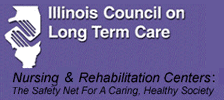|

FOR IMMEDIATE RELEASE
May 22, 2002
Illinois Voters See Health Care as
a Top Priority Issue
for the State Budget
(Chicago) – According to a recent poll, education
and health care are the two top priorities for Illinois
voters. The April 28 Zogby poll, conducted by the St.
Louis Post-Dispatch and KMOV-TV, asked 806
registered voters across the state to name their two top
priorities for budgetary funding in the fiscal crunch.
Eighty-five percent of those polled listed education as
a top concern and 63.3 percent listed health care.
Despite Illinois voters’ overwhelming support for
health care, Governor Ryan’s proposed budget threatens
drastic cuts to social service programs and health care
providers. Nursing homes in particular stand to bear a
heavy blow. The budget calls for an 8.8 percent cut to
Medicaid funding for nursing homes, totaling $171
million. Additionally, since the federal government
matches 50 cents for each dollar of Medicaid funding,
the state also risks losing an additional $85.5 million.
With Medicaid funds financing two-thirds of the state’s
total nursing home expenses, such an extreme cut could
force facilities to cut staff, decrease services or go
bankrupt. "This shows that as a state, we’re not
meeting our responsibilities to our mothers and fathers,
and grandmothers and grandfathers," says Terrence
Sullivan, executive director of the Illinois Council on
Long Term Care. "Illinois already ranks 44th
in the nation in average Medicaid rate paid to nursing
homes. Plus, average costs at nursing homes have risen
61 percent over the past eight years, while Medicaid
rates have increased by only 37 percent. This cut will
only make things worse."
Providing proper health care to the elderly is
becoming an increasingly prominent issue for the state
of the Illinois, particularly with the graying of the
baby boomer population. Persons aged 85 years and above
are now the fastest growing age group in the country.
Between 1994 and 2020, America's 85-and-older population
is projected to double to 7 million and swell to between
19 and 27 million by 2050. Additionally, people 85 years
and older are the heaviest users of long term care --
nearly one in four lived in a nursing home in 1990. The
decisions that are made now
regarding funding for long term care will lay the
groundwork for how millions of people will be cared for
in the future.
According to a report prepared by Voices for Illinois
Children, Illinois ranks 46th in generating
the general revenues that pay for education, public
safety, human services and health care when measured
against the personal income of the state's taxpayers.
That means that the general fund that pays for the
primary services and programs of this state, but not its
roads and other bricks and mortar projects, is poorer
than all but four states. And although Illinois does
have relatively high property taxes, our state still
manages to rank 49th in the total state and
local revenue that it generates, which includes property
taxes and everything else, as a percent of the income of
the state's taxpayers.
State government has a social responsibility to
protect its most frail, particularly during difficult
times. Other states have shown Illinois that with
recession budgets, necessary revenue to support the
elderly can be generated through cigarette taxes, casino
taxes, income taxes, and even borrowing the money
against cigarette settlement money. One other solution
to avoid devastating cuts to Medicaid is to temporarily
increase the provider license assessment. The federal
government matches all monies paid out to Medicaid.
Increasing the provider license assessment costs the
state nothing and will also prevent the loss of needed
Medicaid matching funds. Whatever the solution, every
effort must be responsibly taken to protect our state's
50,000 nursing home residents on Medicaid -- the
proposed $171 million cut will put these Illinois
citizens in peril.
# # #
The Illinois Council on Long Term Care is an
association of nursing home professionals representing
over 200 facilities employing 26,000 staff members who
serve over 38,000 residents. More information about long
term care issues can be found at the Council's web site
www.nursinghome.org.
|

